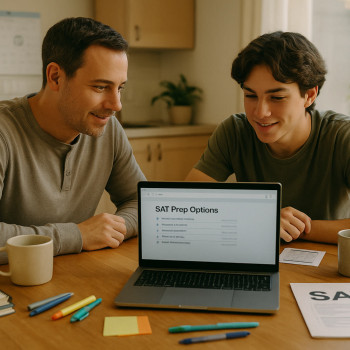Why customized reminders matter for Digital SAT success
Preparing for the Digital SAT isn’t just about how many practice problems you do—it’s about when, how, and with what focus you practice. A generic night-before cram session rarely builds the deep understanding and test-taking stamina you need. That’s where customized study reminders come in: they turn good intentions into small, repeatable actions that compound into real progress. Reminders nudge you to stick to a plan, help you balance practice across Reading & Writing and Math, and keep stress from sneaking up in the final weeks.
Think of a reminder like a friendly coach tapping you on the shoulder—not an alarm that startles and nags, but a thoughtful prompt that fits your day. In this post, you’ll learn practical, step-by-step ways to create reminders using mobile apps, how to tailor them to your study style and life, and how to measure progress without burning out.
Start with the goal: what do you want your reminders to accomplish?
Before you open an app, get clear about what you want reminders to do. Different goals demand different reminder strategies. Here are common SAT objectives and the reminder style that best supports each:
- Build consistency: Short daily reminders to practice vocabulary, read an article, or do 10 math questions.
- Target weaknesses: Weekly reminders that focus on specific weak topics, like geometry or command-of-evidence passages.
- Simulate test conditions: Blocked reminders for full-length practice tests with device setup and checklists.
- Balance study and rest: Reminders for active recovery—stretching, short walks, or a screen break—so you don’t burn out.
- Plan for deadlines: Countdown reminders for registration, score release dates, or college application deadlines.
Choose the right app(s) for your rhythm
No single app is perfect for everyone. The trick is to match an app’s strengths with the reminder role you want it to play.
Types of apps that work well
- Calendar apps (Google Calendar, Apple Calendar): Best for scheduled blocks—full practice tests, tutoring sessions, and registration deadlines. They show daily structure and sync across devices.
- Task & habit apps (Todoist, Microsoft To Do, Habitica): Great for recurring micro-tasks—10-question drills, vocabulary reviews, or daily reading. Many let you set streaks and priority labels.
- Focus & timer apps (Forest, Pomodoro timers): Ideal for enforced focus windows and built-in breaks—excellent for practicing under timed sections to build stamina.
- Note & planner apps (Notion, Evernote): Useful for combining reminders with study content—link problem sets, track progress, and add templates for test-day checklists.
- College Board and BigFuture tools: Official resources help you plan around actual SAT dates and score-release timing; use them alongside study reminders to stay aligned with registration timelines.
Design reminders that respect your real life
Students juggle classes, sports, jobs, and social life. A reminder that expects hours of uninterrupted work at 7 a.m. every day won’t stick. Instead, create reminders around natural pockets of time and energy.
- Map your weekly rhythm: note class blocks, extracurriculars, and commute time.
- Identify micro-opportunities: 15 minutes between classes, a bus ride, or post-dinner wind-down.
- Choose formats that match the slot: micro-practice for short windows; full sections when you have 45–90 minutes.
Example daily rhythm and reminder types
| Time | Slot length | Reminder content |
|---|---|---|
| 7:20–7:35 AM | 15 min | Flashcard review (vocab or math formulas) |
| 4:00–4:30 PM | 30 min | Targeted practice: 10–15 math problems on a weak topic |
| 8:00–9:00 PM | 60 min | Timed Reading section with Pomodoro 25/5 |
| Weekend (Saturday morning) | 3 hours | Full practice test or two adaptive sections |
How to write reminder text that actually works
What you write in a reminder matters. Clear, empathetic, action-oriented text performs better than vague instructions. Here’s a short formula: Action + Duration + Focus + Encouragement.
Examples:
- “Do 10 algebra practice questions (20 min) — focus: systems of equations. You got this!”
- “Timed Reading passage (25 min): Passage 2 — practice evidence questions.”
- “Bluebook setup rehearsal (10 min): confirm device, charger, and ID — calm and ready.”
Smart scheduling techniques to maximize retention
Use these scheduling principles when setting reminder frequency and timing:
- Spaced repetition: Revisit concepts at increasing intervals (1 day → 3 days → 7 days) to lock learning into long-term memory.
- Interleaving: Rotate topics in practice sessions—mix algebra, geometry, and data interpretation rather than doing 50 problems of one type.
- Distributed practice: Shorter, regular sessions beat rare marathon sessions for retention and avoidance of burnout.
- Test-like conditions: Schedule regular reminders for full-timed sections so your body and mind learn the rhythm of the Digital SAT.
Automations and integrations that save time
Modern mobile apps let you automate reminders so you don’t have to create a new one each week. Here are a few practical automations:
- Set recurring reminders for daily habits (e.g., “15-min vocab”) and weekly themes (e.g., “Quantitative Wednesday”).
- Use calendar syncing so practice blocks appear alongside classes; color-code them to prioritize.
- Combine a Pomodoro timer with a habit app: when a Pomodoro ends, Mark the task done automatically.
- Create templates in Notion or a task app for “Practice Test Day” that include device prep, materials checklist, and debrief prompts. Trigger that template the night before a practice test.
Measure progress without getting lost in data
Reminders are most valuable when they link to visible progress. Simple metrics help you see momentum without obsession:
- Completion rate: percent of scheduled reminders you completed each week.
- Focused minutes per week: total minutes spent in timed practice sessions (tracked by a focus app).
- Targeted improvement: score or accuracy on specific topics over time (table below shows a sample tracker).
| Week | Algebra accuracy | Reading evidence accuracy | Timed practice minutes |
|---|---|---|---|
| Wk 1 | 62% | 55% | 180 |
| Wk 4 | 71% | 64% | 420 |
| Wk 8 | 79% | 73% | 760 |
How to use reminders for full-practice-test day
Practice test days need special planning—treat them like mini-test days. Set a series of reminders to create a smooth, realistic simulation:
- Two days before: Reminder to charge your device, download the Bluebook app, and confirm your testing environment.
- The night before: Reminder with a checklist—ID, charger, snacks, quiet space, and estimated finish time.
- One hour before: Short mental warm-up: 10-min light reading and breathwork.
- Immediately after: Reminder to log mistakes for later review and schedule a debrief session within 48 hours.
Personalizing reminders to your learning profile
Two students can use the exact same schedule and get very different results. Personalization makes reminders meaningful:
- If you’re a morning person: Put the heaviest practice in the morning when mental energy is highest.
- If you’re rushed in the afternoon: Reserve afternoons for micro-review and use evenings for deeper practice.
- If you need accountability: Schedule regular check-ins with an accountability partner or your Sparkl tutor; a shared calendar event or a message after each study block can keep the engine running.
- If you procrastinate: Use gamified habit apps that reward streaks and small wins—winning small is motivating.
Using reminders to enhance tutoring sessions
One-on-one guidance amplifies the benefits of reminders. If you work with a tutor—like Sparkl’s personalized tutoring—reminders can be a bridge between sessions:
- Set reminders to complete pre-session practice so tutoring time focuses on strategy, not basics.
- After sessions, schedule follow-up reminders for targeted practice the tutor recommended.
- Use shared calendars to coordinate times and send gentle prompts before each meeting.
Practical templates students can copy right away
Here are three ready-to-use reminder templates you can paste into your calendar or task app. Adjust times and content to match your week.
- Daily micro-practice (15 min): “Daily SAT micro-drill — 15 min. Rotate: Mon vocab, Tue algebra, Wed grammar, Thu data, Fri mixed. Mark done.”
- Weekly review (60 min): “Weekly SAT review — 60 min. Review errors from practice tests this week. Update error log and plan next week’s focus.”
- Weekend mock test (4 hrs): “Full digital SAT simulation — 4 hrs. Device check 30 min before; follow test-day checklist. Debrief scheduled 48 hours later.”
Dealing with missed reminders and plateaus
Missed reminders are normal. The question isn’t perfection; it’s recovery. When you miss a study session:
- Don’t double up to make up time immediately—do a smaller focused session instead so you can sustain the habit.
- Reflect on why you missed it: Was the timing bad? Was the task unclear? Adjust the reminder for next time.
- If progress plateaus, alter the reminder content: shift from volume to targeted strategy (e.g., timing techniques, question triage) rather than more raw practice.
Sample 8-week reminder schedule for the Digital SAT
Below is a compact plan you can import into a calendar. It’s built around the idea of progressive overload: gradually increase focus and test-like practice.
| Weeks | Daily | Weekly | Weekend |
|---|---|---|---|
| 1–2 | 15–30 min micro-practice (skills review) | 60 min review; tutor check-in | 1 timed section (Reading or Math) |
| 3–5 | 30–45 min targeted practice (weak areas) | Timed sections + error analysis | Half practice test (2–3 sections) |
| 6–8 | 30–60 min mixed practice | Full timed sections under test conditions | Full practice test; debrief and tune-up |
Image prompts to make your study space inspiring
Visual cues can help reminders feel meaningful. Place an image of your study checklist or a calm workspace where you’ll see it before practice.
Fine-tuning for Digital SAT specifics
The Digital SAT has its own routines—downloadable Bluebook app, adaptive sections, and different pacing. Make sure your reminders include these logistics:
- Practice on a device similar to test-day setup; schedule reminders to rehearse the Bluebook app experience.
- Set reminders for adaptive-section strategy practice: practice shifting quick decisions when the test adapts to your level.
- Include device checklist reminders: charge, charger, power bank, quiet spot, and good internet if needed for official practice.
Keep it human: voice, tone, and reward
Reminders should feel like encouragement, not punishment. Write them in a tone that motivates you—warm, firm, or playful. Pair completion with small rewards: a 5-minute stretch, a favorite snack, or a short game. Over time, your brain will begin to associate completing reminders with positive feelings, making study habitual.
When it’s time to bring in extra help
If you find your reminders get ignored or practice isn’t improving scores, consider structured support. Personalized tutoring—like Sparkl’s one-on-one guidance—can help by creating tailored study plans, setting realistic reminder schedules aligned to your strengths and deadlines, and providing expert feedback you can’t easily get on your own. Tutors can also help you interpret diagnostic results and refine reminders so every minute of practice counts.
Final checklist: set up your reminder system in 30 minutes
Use this quick checklist to get your reminder system running now:
- Map your weekly availability (10 minutes).
- Choose one calendar app and one habit/timer app (5 minutes).
- Create three recurring reminders: daily micro-practice, weekly review, weekend test (10 minutes).
- Write clear reminder text using Action + Duration + Focus + Encouragement (5 minutes).
- Schedule a weekly sync with a tutor or accountability partner (if using Sparkl, share goals and checkpoints) (optional, 5 minutes).
Parting thought: reminders are the scaffolding, not the ceiling
Reminders are powerful because they shape behavior without stealing willpower. They help you build a steady practice routine, protect your time, and make the long haul of SAT prep feel manageable. But remember: a reminder won’t replace deliberate study—what matters is how you use the time it creates. Keep your prompts clear, compassionate, and connected to tangible goals. Test your schedule, tune it, and let small, consistent actions lead to big gains on test day.
If you’d like, I can create a personalized 8-week reminder calendar you can import into Google Calendar (or Apple Calendar) based on your class schedule and target SAT date. I can also draft reminder text tailored to your strengths and weaknesses so every ping counts. Ready to build it?
















No Comments
Leave a comment Cancel